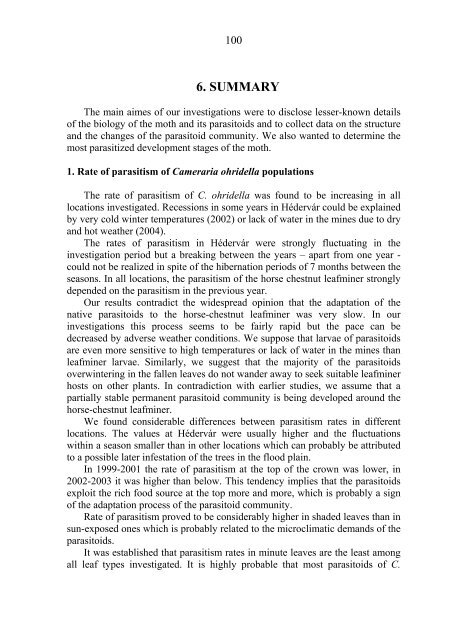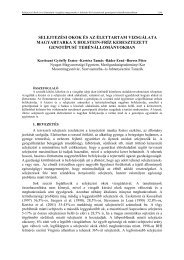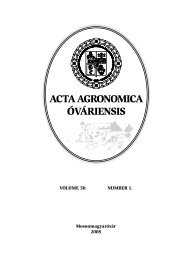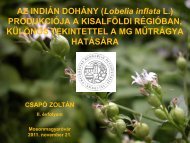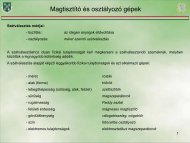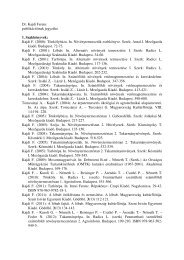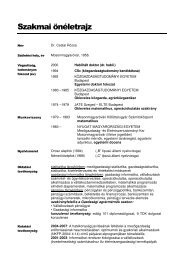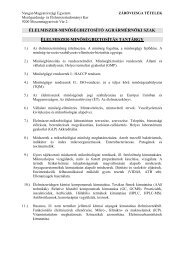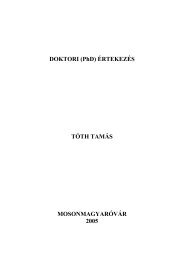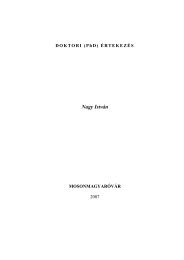DOKTORI (PhD) - Nyugat-Magyarországi Egyetem Mezőgazdaság
DOKTORI (PhD) - Nyugat-Magyarországi Egyetem Mezőgazdaság
DOKTORI (PhD) - Nyugat-Magyarországi Egyetem Mezőgazdaság
Create successful ePaper yourself
Turn your PDF publications into a flip-book with our unique Google optimized e-Paper software.
100<br />
6. SUMMARY<br />
The main aimes of our investigations were to disclose lesser-known details<br />
of the biology of the moth and its parasitoids and to collect data on the structure<br />
and the changes of the parasitoid community. We also wanted to determine the<br />
most parasitized development stages of the moth.<br />
1. Rate of parasitism of Cameraria ohridella populations<br />
The rate of parasitism of C. ohridella was found to be increasing in all<br />
locations investigated. Recessions in some years in Hédervár could be explained<br />
by very cold winter temperatures (2002) or lack of water in the mines due to dry<br />
and hot weather (2004).<br />
The rates of parasitism in Hédervár were strongly fluctuating in the<br />
investigation period but a breaking between the years – apart from one year -<br />
could not be realized in spite of the hibernation periods of 7 months between the<br />
seasons. In all locations, the parasitism of the horse chestnut leafminer strongly<br />
depended on the parasitism in the previous year.<br />
Our results contradict the widespread opinion that the adaptation of the<br />
native parasitoids to the horse-chestnut leafminer was very slow. In our<br />
investigations this process seems to be fairly rapid but the pace can be<br />
decreased by adverse weather conditions. We suppose that larvae of parasitoids<br />
are even more sensitive to high temperatures or lack of water in the mines than<br />
leafminer larvae. Similarly, we suggest that the majority of the parasitoids<br />
overwintering in the fallen leaves do not wander away to seek suitable leafminer<br />
hosts on other plants. In contradiction with earlier studies, we assume that a<br />
partially stable permanent parasitoid community is being developed around the<br />
horse-chestnut leafminer.<br />
We found considerable differences between parasitism rates in different<br />
locations. The values at Hédervár were usually higher and the fluctuations<br />
within a season smaller than in other locations which can probably be attributed<br />
to a possible later infestation of the trees in the flood plain.<br />
In 1999-2001 the rate of parasitism at the top of the crown was lower, in<br />
2002-2003 it was higher than below. This tendency implies that the parasitoids<br />
exploit the rich food source at the top more and more, which is probably a sign<br />
of the adaptation process of the parasitoid community.<br />
Rate of parasitism proved to be considerably higher in shaded leaves than in<br />
sun-exposed ones which is probably related to the microclimatic demands of the<br />
parasitoids.<br />
It was established that parasitism rates in minute leaves are the least among<br />
all leaf types investigated. It is highly probable that most parasitoids of C.


